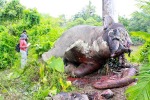1. Another male elephant, Genk, was found dead in Aceh Jaya last year. His poachers are currently on trial.
2. Punishment of elephant poachers is lax in Aceh. Genk’s case is the only one that has reached trial.
Photos by Fakhrizan Mahyeddin
Indonesia: Police apprehend elephant-killers in Sumatra
By Satria Eka Hadinaryanto, 1st May 2014;Eleven people were arrested on April 16 by West Aceh police for allegedly killing a Sumatran Elephant (Elephas maximus sumatranus), in a forest six kilometers away from Teupin Panah village, Kaway XVI, in the West Aceh district.
On April 5, accompanied by a local village official, West Aceh officials finally managed to reach the carcass of the 12-year-old male elephant. The elephant had been dead since April 1, but officials couldn’t get near the location as five other elephants were still guarding the area.
Police officials suspected that the elephant was intentionally killed by a trap and its tusks cut of by chainsaw.
The suspects – five from Ceumara village, one from Babah Lueng village, three from Seumantok village, and two from Teupin Panah village – confessed to killing two elephants in Pante Ceuremen forest and one elephant in Kaway XVI over the course of a year.
“[The suspects] felt threatened by elephants passing their gardens. In addition, one man was killed last year,” said Adj. Sr. Comr. Faisal Rivai, West Aceh police chief, on Wednesday (April 16).
In January, elephants killed one man and injured another in Meureubo sub-district, not far away from Kaway XVI sub-district. Yusmani, of the Ujung Tanoh Darat village, Meureubo sub-district, West Aceh, was killed after being trampled by elephant rampaging through the village. His son, Reverendi, sustained a leg injury from the attack.
Furthermore, Rivai said that they were targeting a bigger elephant in the hopes of getting larger tusks but killed the younger elephant instead.
The elephant that was killed was no stranger to local villagers. He was well-known in the area, often spotted roaming around the village with his herd, comprised of two adult males and three adult females. The area where the carcass was found is designated for human land use and dominated by oil palm plantation, but still has good forest cover.
The suspects allegedly sold the 1.5-kilogram tusk for Rp25 million ($2,158) to a broker.
“We are currently pursuing a broker from South Aceh. [We suspect that] the tusk may have already [been shipped] out of Aceh,” Rivai said.
Genman Suhefti Hasibuan, head of the Aceh Natural Resources Conservation Agency, locally known as BKSDA, said the killing might be connected to illegal trading. To prevent any more elephant killings, the agency is intensifying communications with local villagers.
There may be as many as 500 elephants left in Aceh, nearly one-fifth of the total Sumatran Elephant population. The IUCN estimates that the Sumatran Elephant population has declined more than 50 percent since 1985. During the same period, Sumatra lost nearly 70 percent of its lowland forest – the preferred habitat for elephants.
Poor forest and land management is the primary driver of human-elephant conflicts in Aceh province, which have been intensifying in recent years. Human activities, such as deforestation for plantation, housing, mining, and road developments, are shrinking the elephants’ territories, leading them to rampage through villages. In 2013, eight elephants and one person were killed. However the situation was much worse in 2012, when a total of 25 elephants were killed in Aceh alone. Of these, officials strongly suspect 14 were intentionally poisoned by people working at oil palm plantations as elephants are considered pests by plantation managers.
Hasibuan admitted that law enforcement has yet to implement an effective deterrent against these killings. Of all recorded cases of elephant poaching in the province, only one is being processed in court. That case involved the killing of a male elephant known locally as “Genk” in Sampoinet, in Aceh Jaya district, in July 2013. The 22-year-old was brutally killed, its face was destroyed, its trunk was cut off, and its tusks severed. The killing angered activists and made international headlines. Prompted by the outrage, President Susilo Bambang Yudhoyono instructed Zulkifli Hasan to capture the killers. Currently, the case is still on trial.
Source: Mongabay

